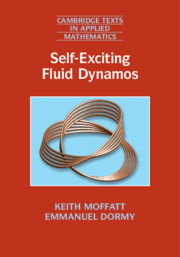Book contents
- Frontmatter
- Dedication
- Contents
- Preface
- Part I Basic Theory and Observations
- Part II Foundations of Dynamo Theory
- Part III Dynamic Aspects of Dynamo Action
- 11 Low-Dimensional Models of the Geodynamo
- 12 Dynamic Equilibration
- 13 The Geodynamo: Instabilities and Bifurcations
- 14 Astrophysical dynamic models
- 15 Helical Turbulence
- 16 Magnetic Relaxation under Topological Constraints
- 17 Magnetic Relaxation in a Low-β Plasma
- Appendix Orthogonal Curvilinear Coordinates
- References
- Author index
- Subject index
16 - Magnetic Relaxation under Topological Constraints
from Part III - Dynamic Aspects of Dynamo Action
Published online by Cambridge University Press: 13 May 2019
- Frontmatter
- Dedication
- Contents
- Preface
- Part I Basic Theory and Observations
- Part II Foundations of Dynamo Theory
- Part III Dynamic Aspects of Dynamo Action
- 11 Low-Dimensional Models of the Geodynamo
- 12 Dynamic Equilibration
- 13 The Geodynamo: Instabilities and Bifurcations
- 14 Astrophysical dynamic models
- 15 Helical Turbulence
- 16 Magnetic Relaxation under Topological Constraints
- 17 Magnetic Relaxation in a Low-β Plasma
- Appendix Orthogonal Curvilinear Coordinates
- References
- Author index
- Subject index
Summary
- Type
- Chapter
- Information
- Self-Exciting Fluid Dynamos , pp. 441 - 462Publisher: Cambridge University PressPrint publication year: 2019



